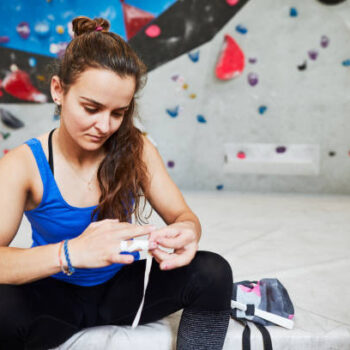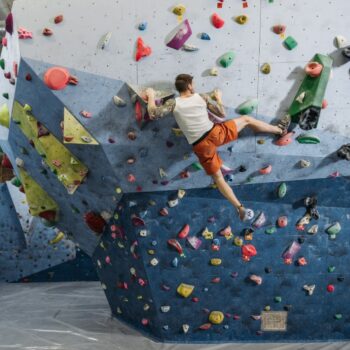Bouldering Guide: The Ultimate Handbook
Interested in bouldering? Want to learn more about the sport? Learn everything you need to know about indoor, outdoor, and competitive bouldering with this definitive bouldering guide.
Table of Contents
What is bouldering?
In this bouldering guide, we would describe bouldering as climbing up an artificial rock wall or natural rock formation as high as 4.5m (15ft) without a rope, but fully equipped with as little as climbing shoes, chalk, and landing pad(s). Or, as John Sherman would argue, “The only gear really needed to go bouldering is boulders.” As a solitary sport, it can take place both indoors and outdoors. Even though it is an individual sport, it is considered a very social sport with many climbers supporting one another to complete routes (bouldering problems) or improve each other’s skills.
What is a bouldering problem? It’s a sequence of technical moves one takes to ascend a route from the start to the top (the last hold in the sequence). Depending on someone’s height, weight, and skill, they may climb the sequence in a different order than another climber, but with the same goal of reaching the top.
In recent years, this sport has been met with a surge in popularity with many new climbers seeking to navigate various problems to achieve the sweet reward of reaching the top. This growth in popularity is due in no small part to the increased visibility of the sport when it was included as an official Olympic sport in the 2020 Tokyo Olympics. With the sport drawing more attention, it has gained climbers due to it being a great way to get outdoors, stay healthy (mentally and physically), and meet new friends.
Indoor vs. Outdoor: What’s the difference?

Bouldering Guide: Indoor
This form of climbing is more commonly known as gym climbing. It’s climbing up an artificial rock wall with pre-set handholds that make up a bouldering problem. Problems, which are designed and set up by routesetters, are not always easy to solve and require a climbing solution (beta) to ascend to the top.
- Problems: Indoor bouldering problems are meant to simulate something you might encounter outdoors. Different ones will help you develop different skills and work on different strengths (i.e. upper body, core, finger). Gyms typically use identifying colors to differentiate the grading of problems. This can come in the form of making all the holds in one sequence the same color or by marking different colored boulders with the same colored tape.
- Holds: The plastic climbing holds adorning the artificial rock walls are the stars of the show. There are various holds you will encounter at the climbing gym:
- Equipment: Climbing shoes (which can be rented for an additional cost at your local climbing gym) and chalk (some small gyms do provide communal chalk, but most places require you to bring your own). You may also consider bringing a chalk bag, finger tape, and/or brushes, but they are not necessary for indoor bouldering. Tip: Climbers tend to prefer using softer shoes for indoor climbing.
- Environment: No matter the weather, everyone can enjoy climbing in the safety of an indoor climbing gym. Since it is an enclosed space, it can be quite noisy from all the hustle and bustle of people climbing or chatting with one another. [Some gyms are also prone to play loud music.]
Tips for Indoor Bouldering
- Start with easier routes: If you’re new to bouldering, start with easier routes to build your strength and technique.
- Focus on footwork: Footwork is a key aspect to bouldering, so practice placing your feet carefully and using your toes to grip the holds.
- Use different holds: Indoor bouldering walls offer a variety of holds, including jugs, crimps, slopers, and pockets. Practice using different types of holds to improve your technique and grip strength.
- Try routes with overhangs: Overhanging routes can be challenging but also offer a great way to improve your core strength and balance.
- Don’t be afraid to fall: Easier said than done, right? Falling is a part of the sport, so don’t be afraid to take risks and push yourself. There are crash pads to break your fall.
Bouldering Guide: Outdoor
Climbing indoors has the luxury of pre-set routes with colorful handholds to guide a climber up the wall. In the outdoors, routes are more difficult to spot on real rock and maneuvering on rock surface can be more challenging. It requires different technique, a stronger stomach for heights, and the ability to tackle more difficult grading to take on outdoor bouldering.

- Problems: To put it simply, they are permanent. Unlike going to your favorite climbing gym and discovering what new problems they have set for you, outdoor problems never change.
- Holds: Unlike the artificial climbing holds you can find indoors, you will encounter the rough, sharp, and sometimes unstable natural rock formations.
- Equipment: Climbing shoes and chalk bag/chalk. In addition, it requires crash pads, spotter(s), and a guidebook or a topo map of the area. You may want to consider also bringing a helmet (optional, but highly suggested for beginners), brushes, and first-aid kit (optional, but best to be prepared for all the cuts and scratches that are likely to occur).
- Environment: The weather can play a huge part in how successful your outdoor bouldering experience is. You must be more aware of the conditions the boulders are in due to the environmental changes that occur outdoors.
Tips for Outdoor Bouldering
- Research the area: Before heading out, look for guidebooks, online resources, or talk to other climbers who have experience in the area. This will help you understand the type of rock, difficulty level, and safety considerations in the area.
- Check the weather: Dry conditions are the best. It is also good to avoid wet or damp rock, which can be slippery and dangerous.
- Start with easy problems: Outdoor bouldering can be more challenging than its counterpart due to the natural terrain and unpredictable conditions. Start with easier problems so that you can get a feel for the rock and get more comfortable solving outdoor bouldering problems.
- Climb with a partner: Unlike indoors, which can be climbed solo, outdoors requires a spotter who can move the crash pads and help you if you fall. It can be very dangerous to climb alone, so best to always bring climb with your buddies.
Bouldering Guide: Competitive Bouldering

The history of competitive bouldering on the international stage dates in 1999 when the IFSC hosted the first ever World Cup Bouldering competition. To this date, bouldering competitions have been taking place locally and internationally. Check out the latest international events here.
Outside our bouldering guide, you can also check out our article on the disciplines of sport climbing to learn about bouldering on the competition circuit.





